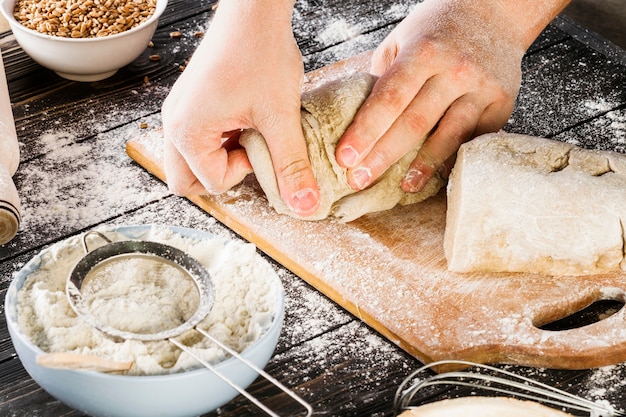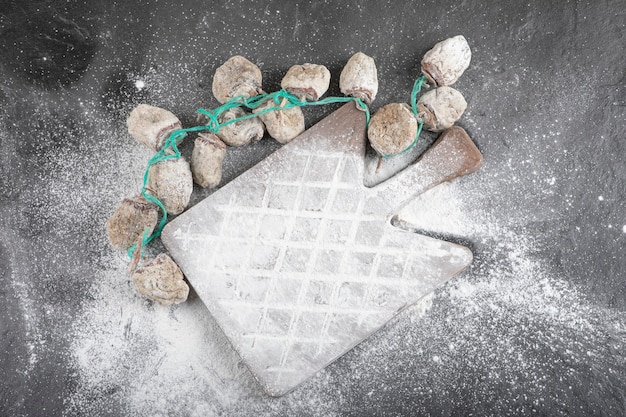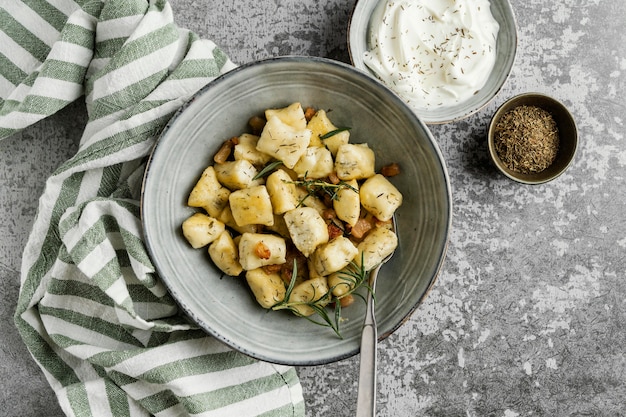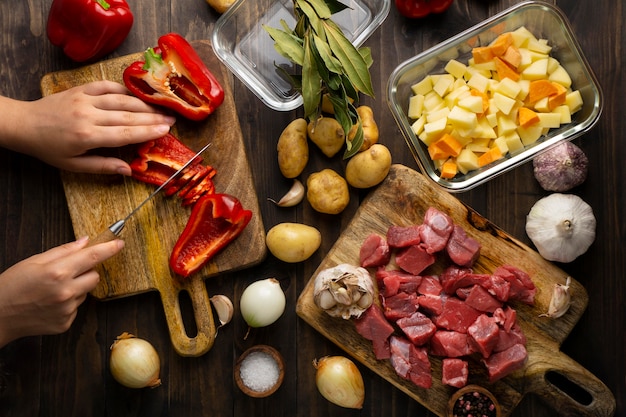Let's be honest, sometimes you just crave a comforting, satisfying meal that's quick and easy to make. And what's simpler than a plate of steaming hot ravioli? But let me tell you, even something as seemingly simple as frozen ravioli can be elevated to a whole new level of deliciousness with just a few tricks up your sleeve.
This isn't just your run-of-the-mill guide. This is a deep dive, a comprehensive exploration of all things ravioli – from choosing the perfect pasta to mastering the art of the al dente bite, we'll cover it all. We'll even tackle those common ravioli cooking pitfalls that can leave you with a soggy mess instead of a delightful dinner.
Get ready to unleash your inner pasta pro and discover the secrets to making frozen ravioli a culinary masterpiece!
(Part 1) Choosing the Ravioli: It All Starts Here

Remember, just like any good dish, the foundation of a delicious ravioli experience starts with choosing the right ingredients. That means going beyond the first bag you see in the freezer aisle and taking the time to make a thoughtful selection.
Types of Ravioli: A World of Flavour
Gone are the days of plain old cheese and spinach ravioli! Nowadays, the freezer aisle is bursting with exciting flavour combinations. You've got ricotta and mushroom, spinach and ricotta, lobster and spinach, butternut squash and sage, even pumpkin and sage. Don't be afraid to break out of your comfort zone and experiment! You might just discover a new favourite flavour that you never knew existed.
The Importance of Freshness
Always check the best before date. While frozen ravioli can last for months, it's always best to opt for the freshest batch possible. You'll notice a difference in texture and flavour when you use ravioli that's closer to its peak.
The Right Size Matters
Think about the sauce you're planning to pair with your ravioli. For a light, simple sauce, smaller ravioli will be perfect. They'll cook quickly and won't be overwhelmed by the sauce. But for a heavier, chunky sauce, go for larger ravioli. They'll hold their own against the sauce and won't get lost in the mix.
Reading the Label: Essential Information
Before you toss those ravioli into your basket, take a peek at the label. It's your key to unlocking all the crucial information about the ravioli, including the ingredients, cooking times, and nutritional content. Pay special attention to the cooking instructions, as different brands have different methods and times.
(Part 2) Prepping for the Perfect Ravioli: Your Kitchen Arsenal

You've got your ravioli, now it's time to make sure your kitchen is ready for the task at hand. This isn't about fancy gadgets or complicated techniques – it's about having the right tools on hand to make the process smooth and efficient.
The Essential kitchen tools
You don't need a Michelin-star kitchen to cook perfect ravioli. Just gather these essential tools:
- A large pot with a lid: This will ensure there's enough space for your ravioli to cook evenly and prevent them from sticking together.
- A slotted spoon or pasta strainer: This is your go-to tool for gently lifting the ravioli from the boiling water and draining it without losing any precious pasta.
- A colander: This will be your trusty companion for draining the ravioli after cooking.
- A serving spoon: This will help you easily portion out your ravioli onto plates.
The Water: Not Just Any Water Will Do
Many people assume any old water will do, but trust me, using fresh, filtered water will make a noticeable difference. You're putting in all the effort to choose the perfect ravioli, why not give it the best possible environment to cook in?
Salt is Your Friend
Never, ever forget the salt! Salting the water brings out the flavour of the ravioli and adds that little extra something special. Aim for about 1 tablespoon of salt per gallon of water. You can always add more if needed.
(Part 3) Cooking Ravioli: The Art of the Al Dente

This is where the magic happens, folks. The secret to perfect ravioli isn't some fancy technique, it's all about knowing how to cook it to that perfect al dente texture. It's that sweet spot between mushy and crunchy, where the ravioli is firm to the bite but not overly chewy.
The Importance of Al Dente
Al dente, which translates to "to the tooth" in Italian, describes pasta that's cooked just enough so that it's still firm to the bite. With ravioli, you want that perfect al dente texture so the filling stays intact and the pasta doesn't fall apart.
Getting Started: The Boiling Water
Fill your pot with plenty of water, about 6-8 quarts. Bring the water to a rolling boil over high heat. This is essential to ensure your ravioli cooks evenly and doesn't get stuck together at the bottom of the pot.
Adding the Ravioli: The Gentle Approach
Once the water is boiling, add your ravioli in batches, leaving enough space between each piece. Don't crowd the pot! You want to ensure that each ravioli has enough room to cook evenly and doesn't become a tangled mess.
The Timing Game: Don't Overcook
The cooking time for ravioli varies depending on the brand and size. Check the package instructions for the recommended time. Generally, it takes about 3-5 minutes. Don't overcook! Overcooked ravioli will become mushy and lose its delicious flavour.
The Test: The Bite Test
The best way to test if your ravioli is cooked is to use the bite test. Take a single ravioli out of the water with your slotted spoon and give it a bite. If it's firm but not hard, it's perfectly cooked.
(Part 4) Draining the Ravioli: A Gentle Touch
Your ravioli is cooked to perfection, now it's time to drain it. This might seem like a simple step, but it's crucial for preserving that al dente texture and preventing a soggy mess.
The Drain and Serve Method: Preserving the Texture
Use a large colander or strainer to drain the ravioli. Avoid rinsing the ravioli after draining. Rinsing will cool the pasta down too quickly and wash away the starch that helps the sauce stick, which is what we want for a delicious, saucy experience.
The Secret to Avoiding Sticking
To prevent your ravioli from sticking together, gently toss them in a tablespoon or two of olive oil. This will help keep them separated and prevent them from clumping.
The Sauce Decision: What to Pair with Ravioli
Now for the fun part: the sauce. Ravioli is super versatile and pairs well with a wide range of sauces. Here are a few ideas:
- Classic Marinara: A simple, yet delicious sauce that never fails. It's the perfect balance of tangy tomatoes and a hint of sweetness.
- Creamy Alfredo: A rich and decadent sauce perfect for those who love a cheesy treat. The creamy texture complements the ravioli beautifully.
- Pesto: A bright and flavourful sauce made with fresh basil, pine nuts, and Parmesan cheese. It adds a touch of freshness and herby goodness to the ravioli.
- Tomato Basil: A light and refreshing sauce perfect for summer. The fresh basil and tangy tomatoes make for a delicious and vibrant sauce.
(Part 5) Serving Your Ravioli: Presentation Matters
You've got the perfect ravioli, cooked to perfection, and paired with a delicious sauce. Now it's time to put it all together and create a beautiful presentation that's as delicious for the eyes as it is for the taste buds.
The Plate Choice: A Touch of Elegance
Choose a plate that complements your ravioli and sauce. A simple white plate lets the colours of the ravioli and sauce shine through. You can also use a patterned plate for a more rustic look.
Garnish It Up: A Finishing Touch
A simple garnish can elevate your ravioli to the next level. Try a sprinkle of freshly grated Parmesan cheese, a few sprigs of fresh basil, or a drizzle of olive oil. These simple additions add a touch of flavour and visual appeal.
The side dish: A Perfect Accompaniment
A simple side dish can make your ravioli meal complete. Consider a green salad, a side of roasted vegetables, or a crusty bread to soak up the sauce. The side dish adds a touch of balance and adds more flavour to the meal.
(Part 6) Ravioli Reheating: Saving Leftovers
We've all been there. You've cooked a massive batch of ravioli, and there's plenty left over. Don't worry, reheating ravioli is a breeze!
The Best Reheating Method: The Stovetop Approach
The best way to reheat ravioli is on the stovetop. Add a little bit of sauce to a pan and heat it over medium heat. Add the ravioli and toss gently until heated through. This method ensures the ravioli reheats evenly and prevents it from becoming mushy.
The Microwave Method: Quick and Easy
If you're short on time, you can also reheat ravioli in the microwave. Place the ravioli on a microwave-safe plate and cover it with a damp paper towel. Microwave on high for 1-2 minutes, or until heated through. This method is quick and easy, but it's important to keep an eye on the ravioli to avoid overcooking.
Avoiding Mushy Ravioli: A Few Tips
To prevent your ravioli from becoming mushy, try adding a splash of water to the pan when reheating on the stovetop. This will help to create steam and reheat the ravioli more evenly. And avoid overcrowding the pan. Give each ravioli enough space to heat up properly.
(Part 7) Beyond the Basics: Exploring Ravioli Variations
Okay, so now you know the basics of cooking frozen ravioli. But what if you want to take things up a notch and explore some exciting new ways to enjoy your favourite pasta? There's a whole world of ravioli variations waiting to be discovered!
Ravioli Soup: A Warm and Comforting Meal
Ravioli soup is a delicious and comforting meal that's perfect for a cold winter day. Simply add your cooked ravioli to a pot of your favourite soup broth. You can add other ingredients like vegetables, meat, or cheese to create a hearty and flavourful soup.
Ravioli Salad: A Light and Refreshing Option
Ravioli salad is a great way to enjoy ravioli in a lighter, more refreshing way. Combine cooked ravioli with your favourite salad ingredients like lettuce, tomatoes, cucumbers, and a light dressing. You can even add a sprinkle of toasted nuts or a drizzle of balsamic glaze for a touch of extra flavour.
Ravioli Bake: A Hearty and Delicious Meal
Ravioli bake is a hearty and delicious meal that's perfect for a crowd. Simply layer cooked ravioli with your favourite sauce, cheese, and other toppings in a baking dish. Bake in the oven until golden brown and bubbly. This is a perfect way to stretch your leftovers and create a satisfying meal.
Ravioli Pizza: A Unique and Creative Twist
Ravioli pizza is a unique and creative way to enjoy ravioli. Spread your favourite sauce on a pizza crust, add cooked ravioli, and top with cheese and other toppings. Bake in the oven until the cheese is melted and bubbly. It's a fun and delicious way to reinvent your favourite pasta.
(Part 8) Ravioli Mishaps: Troubleshooting Common Problems
We've all been there, a ravioli mishap can throw off your whole meal. But fear not, we've got the solutions!
The Mushy Ravioli Disaster: Preventing Overcooking
Overcooked ravioli is a common problem. To prevent this, check the package instructions carefully and don't overcook your ravioli. Use the bite test to ensure it's cooked perfectly al dente. If you're unsure, err on the side of undercooking rather than overcooking.
Ravioli Sticking Together: The Oil Solution
Ravioli sticking together is another common issue. To prevent this, toss your cooked ravioli in a tablespoon or two of olive oil after draining. This will help keep them separated and prevent them from clumping.
A Sauce Disaster: Fixing a Bland Sauce
Sometimes, your sauce just doesn't quite hit the mark. To fix a bland sauce, add a pinch of salt, a sprinkle of pepper, or a splash of lemon juice. You can also add a pinch of sugar to cut through the acidity of tomato sauces.
(Part 9) FAQs: Your Ravioli Questions Answered
Q: Can I cook frozen ravioli from frozen?
A: Absolutely! You can cook frozen ravioli straight from the freezer. Just add a few minutes to the cooking time.
Q: What kind of sauce is best for frozen ravioli?
A: Frozen ravioli is incredibly versatile. You can use anything from a classic marinara to a creamy Alfredo. Experiment and find what you enjoy the most!
Q: How do I store leftover ravioli?
A: Store leftover ravioli in an airtight container in the refrigerator for up to 3 days. You can also freeze leftover ravioli for up to 3 months.
Q: What are some creative ways to use leftover ravioli?
A: Get creative! You can use leftover ravioli to make a delicious soup, salad, or even a pizza topping.
Q: How do I know when my ravioli is cooked?
A: The best way to know when your ravioli is cooked is to use the bite test. If it's firm but not hard, it's cooked perfectly al dente.
I hope this guide has helped you unlock the world of perfect ravioli cooking. Now go forth and conquer your kitchen! And remember, it's all about finding what you love. So get creative, experiment with different flavours, and most importantly, enjoy the deliciousness!
Everyone is watching

Perfect Rice Every Time: The Ultimate Guide to Cooking Rice
Cooking TipsAs a self-proclaimed foodie, I've always been a bit obsessed with rice. It's the foundation of countless cuisi...

Ultimate Guide to Cooking the Perfect Thanksgiving Turkey
Cooking TipsThanksgiving. Just the word conjures up images of overflowing tables laden with delicious food, the scent of r...

The Ultimate Guide to Cooking Asparagus: Tips, Techniques, and Recipes
Cooking TipsAsparagus. The mere mention of this spring delicacy conjures up images of vibrant green spears, crisp and burs...

Can You Cook Spaghetti with Gasoline? (The Shocking Truth)
Cooking TipsWe've all seen those crazy internet trends. You know, the ones that make you wonder, "Did someone actually try...

Chorizo and Eggs Recipe: The Ultimate Guide
Cooking TipsRight, let’s talk about chorizo and eggs. You know, that classic Spanish dish that's always a winner. It's th...
